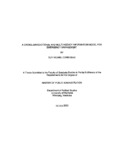| dc.contributor.author | Corriveau, Guy Michel | |
| dc.date.accessioned | 2010-06-21T21:21:04Z | |
| dc.date.available | 2010-06-21T21:21:04Z | |
| dc.date.issued | 2000-07 | |
| dc.identifier.citation | Corriveau, Guy Michel. A Cross-Jurisdictional and Multi-Agency Information Model for Emergency Management; A Thesis Submitted to the Faculty of Graduate Studies in Partial Fulfillment of the Requirements for the Degree of Master of Public Administration, Department of Political Studies, University of Manitoba. Winnipeg, Manitoba, Canada: University of Winnipeg, 2000. | |
| dc.identifier.uri | http://hdl.handle.net/10680/20 | |
| dc.description.abstract | Emergency management and the coordination of disaster-related activity are information-intensive, both in terms of the level of detail required and the diversity of information that must be generated, evaluated, and acted upon. Because the effectiveness of the information system supporting emergency management influences the success of disaster response, a commensurate level of attention to the system through which this information travels in necessary. Although organizations at all three orders of government in Canada are dedicated to emergency management, there are indicators that the response structure may be somewhat ad-hoc and that the information system used to support crisis decision-making may not be fully capable of serving the cross-jurisdictional and multi-agency effort usually associated with disaster response. To optimize coordination in crises, public officials involved in the policy and administration of emergency management must better appreciate and more fully address the distinctive communication and information requirements surrounding emergency management. Serving as a baseline for this study were the various criticisms, made post-Red River Basin flood of 1997, that overall coordination across the municipal, provincial, and federal jurisdictions was lacking and that decision-making and response activity, in general, were delayed. Based on the literature reviewed, the interviews conducted, the author's personal experience, and the use of Structured Systems Analysis and Design Methodology, this study proposes a simple and effective cross-jurisdictional and multi-agency information model for emergency management. A well-designed information system is “the most important tool of crisis management” (Heath 1999). The model proposed in this paper is one upon which subsequent design and implementation of such a system may be undertaken. | en_US |
| dc.description.uri | http://winnspace.uwinnipeg.ca/bitstream/handle/10680/20/Corriveau_Guy_Michel_Thesis.pdf | |
| dc.language.iso | en | en_US |
| dc.publisher | University of Winnipeg | |
| dc.rights | info:eu-repo/semantics/openAccess | |
| dc.subject | Emergency management | en_US |
| dc.subject | Disaster Response | en_US |
| dc.subject | cross-jurisdiction | en_US |
| dc.title | A Cross-Jurisdictional and Multi-Agency Information Model for Emergency Management | en_US |
| dc.type | Thesis | en_US |
| dc.description.degree | Master of Public Administration | |
| dc.publisher.grantor | University of Manitoba | |
| thesis.degree.discipline | Public Administration | |
| thesis.degree.level | masters | |
| thesis.degree.name | Master of Public Administration | |
| thesis.degree.grantor | University of Manitoba | |

